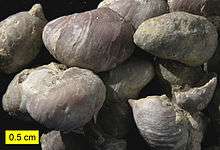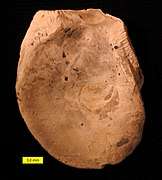Pycnodonte
Pycnodonte is a genus of extinct oysters, fossil marine bivalve mollusks in the family Gryphaeidae, the foam oysters or honeycomb oysters. Shells of species in this genus are found around the world in fossil shell beds from the Valanginian (140.2 Ma) to the Early Pleistocene (0.781 Ma).[2] They are a commonly found fossil in Cretaceous shellbeds of the Navesink Formation in New Jersey.[3]
| Pycnodonte | |
|---|---|
 | |
| A group of Pycnodonte pulaskiensis fossils from the Clayton Formation, (Paleocene) of Mississippi | |
| Scientific classification | |
| Kingdom: | Animalia |
| Phylum: | Mollusca |
| Class: | Bivalvia |
| Order: | Ostreida |
| Family: | Gryphaeidae |
| Genus: | †Pycnodonte Fischer von Waldheim (1835)[1] |
Species
Species within the genus Pycnodonte include:[4]
- Pycnodonte amakusensis Tashiro 1978 †
- Pycnodonte belli (Stephenson, 1941) †
- Pycnodonte brongniarti (Bronn 1831) †
- Pycnodonte callifera (Lamarck, 1819) †
- Pycnodonte convexa (Say 1820) †
- Pycnodonte costei Coquand 1869 †
- Pycnodonte heermanni Conrad 1855 †
- Pycnodonte kansasense Bottjer †
- Pycnodonte mutabilis (Morton, 1828) †
- Pycnodonte newberryi (Stanton) †
- Pycnodonte percrassa Conrad 1840 †
- Pycnodonte roanokensis (Cragin, 1893) †
- Pycnodonte squarrosa de Serres 1843 †
- Pycnodonte taniguchii[5] †
- Pycnodonte trigonalis†
- Pycnodonte vesicularis (Lamarck 1806) †
- Pycnodonte vesiculosa Sowerby 1822 †
- Pycnodonte wardi (Hill and Vaughan, 1898) †
Fossils of species within this genus have been found all over the world in sediments from Cretaceous to Quaternary (age range: 140.2 to 0.0781 million years ago).
The fossils generally exist in large layers or beds. In Utah, in the Capital Reef National Park area, this layer of fossils is up to ten feet thick, and is present in the lower Tununk section of the Mancos Shale Fraction, just above the Dakota Sandstone and below the Blue Gate Shale layer. In the Hanksville, Utah area, the Pycnodonte newberryi oyster bed is exposed over a large area. Studies are currently being conducted to determine whether there is more than one species in these beds.
Gallery
 Pycnodonte vesicularis left valve interior; Aubeterre Formation, Campanian, SW France.
Pycnodonte vesicularis left valve interior; Aubeterre Formation, Campanian, SW France. Pycnodonte vesicularis right valve interior; Aubeterre Formation, Campanian, SW France
Pycnodonte vesicularis right valve interior; Aubeterre Formation, Campanian, SW France- Pycnodonte brongniarti
 Pycnodonte vesicularis MHNT
Pycnodonte vesicularis MHNT
References
- "Pycnodonte (Pycnodonte)". The Paleobiology Database. Archived from the original on 2011-07-20. Retrieved 2009-05-02.
- "Pycnodonte: Age Range and Collections". The Paleobiology Database. Archived from the original on 2011-07-20. Retrieved 2009-05-02.
- "Late Cretaceous Stratigraphic Units of the Coastal Plain". United States Geological Survey. July 22, 2003. Retrieved 2009-05-02.
- Fossilworks Fossilworks
- "Pycnodonte taniguchii". The Comparative Toxicogenomics Database. March 23, 2009. Retrieved 2009-05-02.
| Wikispecies has information related to Pycnodonte |